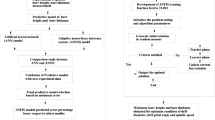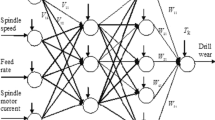Abstract
The burrs at the hole exit degrade the performance in precision part and affect the reliability of the product. Hence, it is essential to select the optimal process parameters for minimal burr size at the manufacturing stage so as to reduce the deburring cost and time. This paper illustrates the application of particle swarm optimization (PSO) to select the best combination values of feed and point angle for a specified drill diameter in order to simultaneously minimize burr height and burr thickness during drilling of AISI 316L stainless steel. The burr size models required for the PSO optimization were developed using artificial neural network (ANN) with the drilling experiments planned as per full factorial design (FFD). The PSO optimization results clearly indicate the importance of larger point angle for bigger drill diameter values in controlling the burr size.
Similar content being viewed by others
References
Davim J. P., Gaitonde V. N., Karnik S. R. (2008) Investigations into the effect of cutting conditions on surface roughness in turning of free machining steel by ANN models. Journal of Materials Processing Technology 205(1–3): 16–23
Dornfeld D. A., Kim J., Dechow H., Hewson J., Chen I. J. (1999) Drilling burr formation in titanium alloy, Ti-6Al-4V. Annals of CIRP 52(1): 45–48
Elbeltagi E., Hegazy T., Grierson D. (2005) Comparison among five evolutionary-based optimization algorithms. Advanced Engineering Information 19(1): 43–53
Fausett L. (1994) Fundamentals of neural networks: Architectures, algorithms and applications. Prentice-Hall, NY
Gaitonde, V. N., Karnik, S. R., Achyutha, B. T., & Siddeswarappa, B. (2007a). Methodology of Taguchi optimization for multi-objective drilling problem to minimize burr size. International Journal of Advanced Manufacturing Technology, 34 1–8.
Gaitonde V.N., Karnik S.R. (2007b) Taguchi robust design for multi-response drilling optimization to minimize burr size using utility concept. International Journal of Manufacturing Research 2(2): 209–224
Gaitonde V. N., Karnik S. R., Achyutha B. T, Siddeswarappa B. (2008) Taguchi optimization in drilling of AISI 316L stainless steel to minimize burr size using multi-performance objective based on membership function. Journal of Materials Processing Technology 202: 374–379
Gaitonde V. N., Karnik S. R., Achyutha B. T., Siddeswarappa B., Davim J. P. (2009) Predicting burr size in drilling of AISI 316L stainless steel using response surface analysis. International Journal of Materials and Product Technology 35(1–2): 228–245
Gaitonde V. N., Karnik S. R., Davim J. P. (2010) Study of the effects of MQL and cutting conditions in turning of brass using artificial neural network. International Journal of Materials and Product Technology 37(1–2): 155–172
Gillespie L. K. (1975) The $2 billion deburring bill. Manufacturing Engineering Management 74: 20–21
Gillespie L. K. (1979) Deburring precision miniature parts. Precision Engineering 1(4): 189–198
Gillespie, L. K. (1996). Standard terminology for researchers of burrs and edge finishing. WBTC STD-02.
Gillespie L. K., Blotter P. T. (1976) The formation properties of machining burrs. ASME Journal of Engineering for Industry 98(1): 66–74
Guo Y. B., Dornfeld D. A. (2000) Finite element modeling of drilling burr formation process in drilling 304 stainless steel. ASME Journal of Manufacturing Science and Engineering 122(4): 612–619
Hunag M. F. (2004) Application of grey-Taguchi method to optimize drilling of aluminum alloy 6061 with multiple performance characteristics. Materials Science and Technology 20: 528–532
Karnik S. R., Gaitonde V. N. (2008) Development of artificial neural network models to study the effect of process parameters on burr size in drilling. International Journal of Advanced Manufacturing Technology 39: 439–453
Karnik S. R., Gaitonde V. N., Mata F., Davim J. P. (2008a) Investigative study on machinability aspects of unreinforced and reinforced PEEK composite machining using ANN model. Journal of Reinforced Plastics and Composites 27(7): 751–768
Karnik S. R., Gaitonde V. N., Rubio J. C., Correia A. E., Abrao A. M., Davim J. P. (2008b) Delamination analysis in high speed drilling of carbon fiber reinforced plastics (CFRP) using artificial neural network model. Materials and Design 29(9): 1768–1776
Karnik S. R., Gaitonde V. N., Davim J. P. (2008c) A comparative study of the ANN and RSM modeling approaches for predicting burr size in drilling. International Journal of Advanced Manufacturing Technology 38: 868–883
Kennedy, J., & Eberhart R. C. (1995). Particle Swarm Optimization. In Proceedings of IEEE international conference on neural networks (pp. 1942–1948). Perth, Western Australia: University of Western Australia.
Kim J., Dornfeld D. A. (2000) Development of a drilling burr control chart for low alloy steel, AISI 4118. Journal of Materials Processing Technology 113: 4–9
Kim J., Min S., Dornfeld D. A. (2001) Optimization and control of drilling burr formation of AISI 304L and AISI 4118 based on drilling burr control charts. International Journal of Machine Tools and Manufacture 41: 923–936
Ko S. L., Lee J. (2001) Analysis on burr formation in drilling with new concept drill. Journal of Materials Processing Technology 113: 392–398
Koelsch, J. (2001). Divining edge quality by reading the burrs. Quality Magazine, pp. 24–28.
Lauderbaugh L. K. (2009) Analysis of the effects of process parameters on exit burrs in drilling using a combined simulation and experimental approach. Journal of Materials Processing Technology 209: 1909–1919
Lin R. (2002) Cutting behavior of a TiN-coated carbide drill with curved cutting edges during the high speed machining of stainless steel. Journal of Materials Processing Technology 127: 8–16
Math Works Incorporation. (2005). MATLAB User Manual, Version 7.1, R 14, Natick, MA.
Min S., Dornfeld D. A., Kim J., Shyu B. (2001a) Finite element modeling of burr formation in metal cutting. Machining Science and Technology 5(2): 307–322
Min S., Kim J., Dornfeld D. A. (2001b) Development of a drilling burr control chart for stainless steel. Transactions of NAMRI/SME 28: 317–322
Montgomery D. C. (2003) Design and analysis of experiments. Wiley, NY
Pande S. S., Relekar H. P. (1986) Investigations on reducing burr formation in drilling. International Journal of Machine Tool Design Research 26: 339–348
Parsopoulos K. E., Vrahatis M. N. (2004) On the computation of all global minimizers through particle swarm optimization. IEEE Transactions on Evolutionary Computing 8(3): 211–224
Phadke M. S. (1989) Quality Engineering Using Robust Design. Prentice Hall, Englewood Cliffs, NJ
Saunders L. K. L. (2003) A finite element modeling of exit burrs for drilling of metal. Finite Element in Analysis and Design 40(2): 139–158
Schalkoff R. B. (1997) Artificial neural networks. McGraw-Hill International Edition, NY
Stein J. M., Dornfeld D. A. (1997) Burr formation in drilling miniature holes. Annals of CIRP 46(1): 63–66
Tosun N. (2006) Determination of optimum parameters for multi-performance characteristics in drilling by using grey relational analysis. International Journal of Advanced Manufacturing Technology 28: 450–455
Author information
Authors and Affiliations
Corresponding author
Rights and permissions
About this article
Cite this article
Gaitonde, V.N., Karnik, S.R. Minimizing burr size in drilling using artificial neural network (ANN)-particle swarm optimization (PSO) approach. J Intell Manuf 23, 1783–1793 (2012). https://doi.org/10.1007/s10845-010-0481-5
Received:
Accepted:
Published:
Issue Date:
DOI: https://doi.org/10.1007/s10845-010-0481-5




